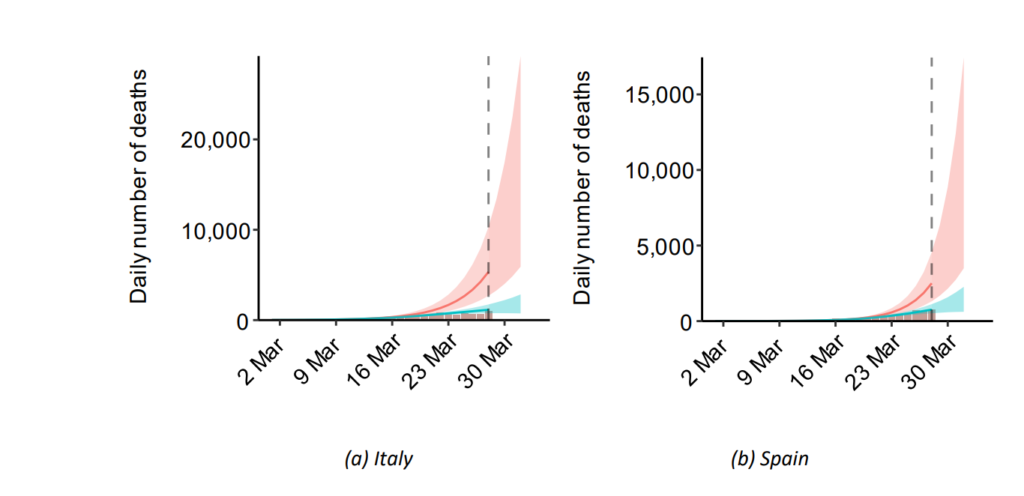
After the novel coronavirus first surfaced in Wuhan, China, where it sowed a devastating pandemic, it is now Europe’s turn to face the brunt of the carnage.
As leaders from the old continent saw death tolls rising at an exponential rate in places like Italy and Spain, they knew something had to be done. Their action plan is now known and felt by most European citizens, who are forced to live through unprecedented restrictions in peacetime.
This all makes sense, though. The reasoning is that we have to temporarily sacrifice our livelihoods, in order to save lives in the future.
Almost 60,000 fatalities have been averted in 11 European countries
We also now have evidence that this works. According to British researchers at Imperial College London, as many 59,000 fatalities have been averted in 11 European countries since distancing measures were imposed by local authorities. There are actually 44 countries in Europe so the real number of averted deaths could be much higher.
There’s still so much we don’t know about the novel coronavirus, but while scientists might debate the exact figures, one thing’s for sure: the novel coronavirus is extremely contagious.
One often-cited figure is that of virus’ rate of transmission, often denoted as R0 by epidemiologists, which hovers at around 2.5 (twice as contagious as the flu). This means that for each person that gets infected, if there is absolutely no social distancing measure in place, another 2.5 people will get infected, which in turn will go to infect another 2.5 people and so on.
In the space of a month, one infected person leads to about 400 additional cases, according to Adam Kucharski, a mathematician who specializes in disease outbreaks.
However, if you close schools and universities, ban public gatherings, and enforce guidelines on hygiene and social distancing, this rate will go down dramatically.
But since it takes around 5 days on average for an infected person to start exhibiting symptoms, and another 15 days on average for an infected person to potentially die, there’s an inherent lag between the moment restrictions are imposed and their actual impact.
This lag has been accounted for by the study “by calculating backwards from the deaths observed over time to estimate transmission that occurred several weeks prior, allowing for the time lag between infection and death.”
And, according to the results, we aren’t suffering in vain.
“In Italy, we estimate that the effective reproduction number, Rt, dropped to close to 1 around the time of lockdown (11th March), although with a high level of uncertainty,” the authors wrote.
An epidemic can be contained and even eradicated as soon as the reproductive number is below zero. We’re not there yet but it’s clear that social distancing and other strict measures work.
” With current interventions remaining in place to at least the end of March, we estimate that interventions across all 11 countries will have averted 59,000 deaths up to 31 March [95% credible interval 21,000-120,000]. Many more deaths will be averted through ensuring that interventions remain in place until transmission drops to low levels,” the authors added.

Italy and (b) Spain from our model with interventions (blue) and from the no interventions counterfactual model (pink). Credit: Imperial College London.
43 million might already have COVID-19 in Europe
Perhaps the most striking information found in the new report by scientists at Imperial College has to do with their estimates of the number of people infected in each country.
As many as 43 million people might be infected in the 11 European countries included in the study.
“We estimate that, across all 11 countries between 7 and 43 million individuals have been infected with SARS-CoV-2 up to 28th March, representing between 1.88% and 11.43% of the population.”
The most affected countries are Spain and Italy, while the least affected counties, in terms of the proportion of the population infected to date, were Germany and Norway.
| Country | % of total population that is infected (estimate) |
| Austria | 1.1% |
| Belgium | 3.7% |
| Denmark | 1.1% |
| France | 3% |
| Germany | 0.72% |
| Italy | 9.8% |
| Norway | 0.41% |
| Spain | 15% |
| Sweden | 3.1% |
| Switzerland | 3.2% |
| Great Britain | 2.7% |
| Source: Imperial College, “Report 13: Estimating the number of infections and the impact of non-pharmaceutical interventions on COVID-19 in 11 European countries.” |
The influential modeling group at Imperial College London made another striking estimate: As many as 90% of the world’s population could become infected by the new coronavirus, killing 40.6 million people, if no measures are put in place to keep the pandemic at bay.
In contrast, social distancing, massive testing, and isolating confirmed cases could bring the worldwide death toll to 1.9 million — that’s a more than 20-fold reduction in fatalities.
So, there you have it: social distancing works. Stay at home!


